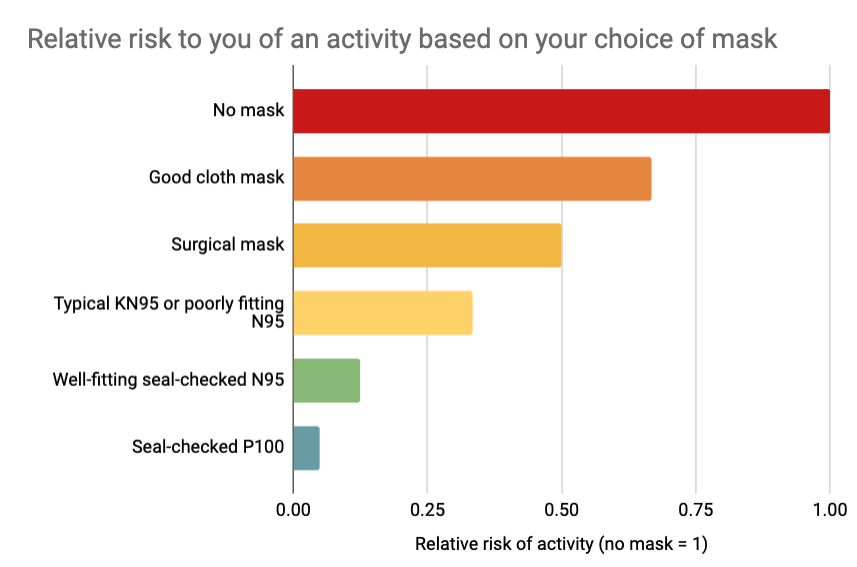
A new online calculator called microCOVID can give you an estimate of your risk of contracting Covid-19 by just inputting information about your environment and what is going on around you.
The online application uses the most recent data available to give you an approximation of your chances of contracting the coronavirus in different settings.
MicroCOVID is an attempt to collate information and calculate all the risks involving the virus, which are changing all the time as the Delta variant makes its way into every county of the country and virus measures change every single day.
A certain scenario — for example, a vaccinated person who is eating at an indoor restaurant with his friends, in any county of the United States — will produce an estimated numerical risk of contracting the coronavirus.
Ben Shaya, a contributor to the microCOVID project, explains to reporters “It gives you a kind of common playing ground for understanding all sorts of activities,” adding “It separates some of the emotional load out of it.”
Shaya, who lived in a “pandemic pod” of housemates and friends during the worst of the Covid-19 crisis, wished there were a more concrete way of knowing just what the risks were regarding partaking in some of his favorite activities once life started up again.
He and his friends “wanted to have a better way to be fair about what people could do,” he explains.
Taking this to its logical conclusion, Shaya and his friends created a mathematical model that employs the latest research on masking, the efficacy of vaccines, the number of current cases in each county of the United States, and other information, and gives that a numerical value.
Initially intending the tool to be used by them alone after creating it in May of 2020, it was only a matter of a few months before they went on to create a version for the general public as well.
The microCOVID website actually includes two different tools: a calculator and a risk tracker. The calculator, which can be used quickly to assess the exact risk of a single activity, can be used on the fly.
The risk tracker takes notice of all a person’s activities that they input to come up with an overall risk score to not only give them a larger view of their coronavirus risk but to enable them to share that information with others.

From something used by just a few friends, Shaya’s brainchild grew to include dozens of volunteer collaborators over the next several months — even including mathematicians, data scientists and a primary care clinician to help determine risks.
All risk of contracting the coronavirus is expressed in microCovids, which represent a one-in-one-million chance of contracting Covid-19.
The basic level of risk is 10,000 microCOVIDs per person each year, which represents a 1 percent chance of contracting Covid-19, according to Shaya.
Some scenarios that users can choose include attending a crowded party or just meeting one friend for dinner; they then must enter information such as what type of mask they are planning to wear, whether or not they are fully vaccinated, and if the event will be taking place indoors or outdoors.
Much like the maps used by national centers for disease control, Shaya’s tool uses color codes to denote risk. Someone who lives in Manhattan but who is fully vaccinated and who also wears an N95 mask might incur risk of approximately 4 microCOVIDs if they went grocery shopping for the period of one hour, for example.
Having a default budget of 200 microCOVIDs for each week per person, such an activity would be considered a “low risk,” or green, thing to do.
In contrast, someone else from the same area but who has had no vaccinations at all and refuses to wear a mask would incur a risk approaching 80 microCOVIDs. It might not sound like a lot, but that is almost half the risk for one week used up in one shopping trip.
Complex activities involving weddings and other major public events can also be put through the calculator to arrive at the relative risk posed.
An unvaccinated person attending an outdoor wedding in Miami at which there will be 100 guests — some of whom are fully vaccinated and some who are not. Of course, because there will be eating and drinking, no one can wear a mask during that part of the celebrations. All told, it may mean five hours of interaction with individuals who care not socially distancing.
According to microCOVID, this is a scenario that most likely should be avoided since the risk is calculated to be approximately 3,000 microCOVIDs, or what it considers to be “dangerously high risk.”
If the person in question him or herself is fully vaccinated against Covid-19, however, that lessens the chances that they could become infected; in that case, it would still be considered “very high risk,” though, at 500 microCOVIDs.
All of the calculator’s parameters are adaptable, so users can change their budget depending on their particular concerns and any issues that people around them might have.
Jenny Wong, one of the contributors to the microCOVID project, says “Nobody thinks they’re being dangerous. ‘Careful’ means different things with different people.”
The risk tracker can simply be viewed like a financial budget, according to Wong, making it clearer just what the implications are of engaging in certain activities. Activities that are riskier might be passed over for other, equally risky, events that are more important later on in the week. Wong says that enables people to “save up for the things that matter to them.”
Monica Gandhi, an infectious disease doctor at the University of California, San Francisco, who is not involved in microCOVID, states “The way we’ve posed the pandemic is that any venture outside your home is very risky, and anything inside is fine. And that, of course, is not exactly how life works. It tells you okay, how do you directly compare eating at a restaurant to sitting on a plane for three hours?”
The Delta variant threw a bit of a monkey wrench into the algorithms, but the microCOVID team dealt with its threat by updating update the calculator and risk tracker to account for its greater virulence.
Wong stated that this means the relative risk of many daily activities has been significantly altered. “I went from, ‘I can do this once a week,’ to maybe a once-every-two-months activity,” she explains.
Even with amazing tools like microCOVID risk assessments, this doesn’t mean people can behave with impunity just because they use it. F. Perry Wilson, an epidemiologist at Yale University, who is not involved in microCOVID, is wary of the tool in that it can provide “a false sense of security,” he warns, adding, it “might give people sort of permission to behave in ways that might put them in more danger than they appreciate.”
See all the latest news from Greece and the world at Greekreporter.com. Contact our newsroom to report an update or send your story, photos and videos. Follow GR on Google News and subscribe here to our daily email!



